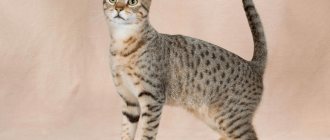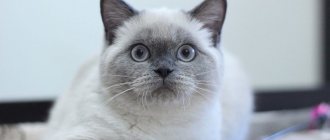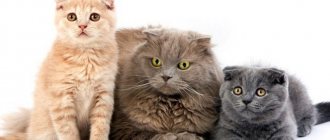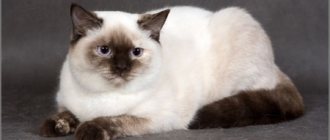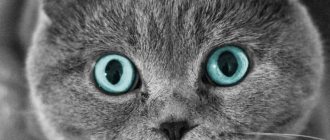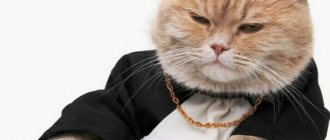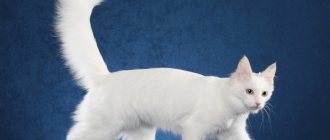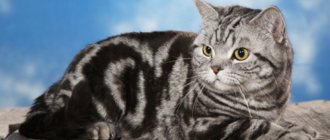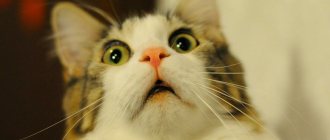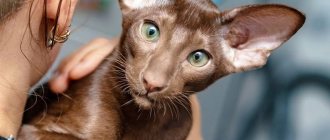magazine "CATS info" No. 1 2004
They appeared on the Russian and world felinological arena already with a sonorous name - Neva Masquerade, and this, together with their extravagant appearance, somehow immediately distinguished them among Siberians of different colors. Enthusiastic responses from judges, bright victories in “Best in Show”, increased attention of spectators at exhibitions, the use of the image of the Neva masquerade cat in advertising, today, like ten years ago, speak of their true beauty and enduring popularity. They immediately won hearts. The number of breeders and nursery owners who want to deal specifically with Siberian Color Points has grown incredibly in recent years, and the activity of these breeders, the desire to exhibit their animals and work has led to the fact that today’s Neva Masquerade can be safely called one of the most important achievements of domestic cat breeding. Their name is pronounced and written in almost all languages of the world.
The first breeders of Nevaks 10-15 years ago, buying at the bird market, picking up phenotypic kittens on the street, hardly prophesied for their descendants that incredible popularity, all the joy and all the burden of which they are now experiencing. It would seem that it could be simpler: just a Siberian cat and just a color-point color, but out of thousands of combinations of traits characteristic of different breeds with different colors, Neva Masquerade cats are one of the most ingenious works of nature. The light color well emphasizes the texture of the coat characteristic of Siberians, and the blue eyes add additional depth to the look that has preserved the pristine freedom of its wild ancestors. I would even like to say that the Siamese color suits the Nevaks more than the Siamese cats themselves, but I’m afraid that then the Siamese owners will be offended by me. In any case, ironically, out of all the variety of colorpoints of various breeds, this color suited the Siberians surprisingly well.
From the history
Unfortunately, beautiful legends are not associated with their origin, such as, for example, with the origin of Siamese or Burmese cats, but Siberians themselves became a legend, a legend of Russian felinology: it was with the recognition of this aboriginal breed and the appearance of Siberian cats at foreign exhibitions that young Russian felinology for the first time loudly, throughout the world declared itself, and the Neva Masquerade Parties shared this glory to the fullest. Their poetic name is a tribute to the city where the selection of these cats began in the Kotofey club under the leadership of Olga Mironova 15 years ago. Despite the fact that the name is more common than official, it turned out to be so successful and caught on so much that at the beginning it even caused a little confusion in the family relations of its owners with Siberians of other colors: it is still in print, in exhibition catalogs, On the pages of Internet sites you can find the phrase: “Neva masquerade breed.” This is not correct, there is no such breed, but there is a Siberian color point.
The unified standard for Siberian and Neva masquerade cats was adopted by the SFF in the same 1990. The author of the standard is Olga Sergeevna Mironova. The WCF standard was adopted in 1994 and published in the WCF Standards Collection in 1995. Later, changes were made to the standard, but not significant.
About breeding
Work with Siberian colorpoints, having begun in St. Petersburg, quickly captured Moscow, where, judging by the latest exhibitions, it received the greatest development. Nurseries in St. Petersburg and Moscow for a long time carried out breeding work independently of each other, and even now the lines of St. Petersburg and Moscow Nevaks intersect only in Western European countries, where the number of natives of both cities is approximately the same. Direct exchange of breeding material between the two felinological capitals of our country is rarely practiced. In other large cities of Russia, breeding of Siberians in general and Neva Masquerade in particular is not proceeding at the same Stakhanov pace as in the capitals. This is largely due to financial difficulties. in Novosibirsk or Yekaterinburg, a Neva masquerade kitten with a pedigree can be bought for 500 rubles, while breeding animals from Moscow are exported to these cities for hundreds of dollars. Despite this, in different parts of Russia there are many true fans of this breed, whose work is based only on great enthusiasm and sincere love for Siberian cats, which is sometimes lacking in some metropolitan breeders.
But abroad, especially in the United States and Western Europe, the popularity of nevaks has long gone beyond the bounds of human imagination. Siberian cats are by far the most “exported” from Russia and most of them are color points. If earlier foreign Siberian nurseries could be counted on one hand, now they appear in dozens every year and after a couple of years of their existence they themselves begin to successfully export cats to neighboring countries. Germany probably has the largest number of Nevaks per capita; there are even special breed clubs there; in Great Britain, the Neva masquerade appeared only in 2001, they say that this event was even written about in the newspaper; The year 2003 was marked by the fact that the first Neva Masquerade nursery arose in South Korea; The Republic of South Africa is now showing great interest in our aboriginal breeds, so the triumphal procession of the Nevaks around the World continues.
The main problem in breeding Siberian color-point cats today is perhaps the different understanding of the standard of the Siberian cat by different experts. Although it is generally accepted that the predominance of certain traits in a breed depends primarily on the breeders, the opinion of experts plays an important role. Giving preference to the showiness of a cat over its breed quality, experts often provoke breeders to consolidate those characteristics that make the cat’s appearance excessively decorative and neglect the qualities that distinguish the native breed. It can be difficult to convince the owners of nurseries who raise Siberians of excellent type with high-quality wool that they are going the right way if at exhibitions they lose to beautiful, bright cats that do not quite meet the standard.
Compared to other breeds of the so-called “forest type”, for example, Norwegian Forest or Maine Coons, the Siberian breed is still very young and is in that stage of formation, which is actually characteristic of a breed with a fifteen-year history of official existence. Neva masquerade cats with a full four-generation pedigree are still very rare. The first Neva masquerade producers had neither pedigrees nor any other documents of origin. The most famous of them is the World Champion cat Maurice, whom Moscow Nevak owners call nothing less than “everyone’s great-grandfather.” St. Petersburg also has its own famous sires, for example, World Champion Max, whose name appears in many pedigrees of St. Petersburg Nevaks. Since the history of the breed fits well within the framework of one cat’s life, many of its ancestors are still alive and well.
Nevak breeders are very active both in their nurseries and in the public field of domestic felinology, studying in felinological courses, attending seminars, and participating in exhibitions. Now in Russia there are more than 100 nurseries of Siberian cats specializing in color point color. The largest number of nurseries and independent breeders of these cats is in the “Association of Siberian Cat Lovers” in Moscow. Different nurseries have different goals and use different means to achieve them. Some, focusing on the merits of their most prominent ancestors, resort to inbreeding; others prefer to improve their livestock by infusing the blood of the best phenotypic animals of unknown origin (as is known, the class of beginners in the Siberian breed is not yet closed and Siberians “from the street” can be used in breeding work); Still others practice mating color-points with Siberians of “traditional” colors; this also brings excellent results and the number of “mixed” nurseries is constantly growing. But many breeders diligently cultivate the traits inherent in their pets, considering their cats to be the most correct. But it’s so easy to disrupt the harmony present in the entire appearance of the Siberian cat. A description of her appearance might sound like this: “Not too big ears, not too long hair, not too long or short muzzle, etc.” Unlike most breeds, the purpose of selection of which is the extremalization of individual traits, in Neva Masquerade (and Siberians in general) all traits are moderately expressed, but at the same time, the image of the Nevak (Siberian) as a whole is beautiful, bright and easily recognizable. This is true harmony. This is why all Siberians look natural, whether they are out in the wild catching mice or in the palace at a reception with the queen. Today, there are three most common types of Neva Masquerade (if we take Siberians of all colors in general, then there are about five such types), they all fit within the framework of the standard. The main difference is in the proportions of the muzzle and the lines of the head. The "muzzles" coming from different leading nurseries are easily recognizable. At the first stages of breeding, the differences were more obvious, and after a few decades (if the work is going in the right direction) they should smooth out, perhaps then experts will be able to finally edit the standard and no longer deviate from it one iota.
Breed cost
Any nursery in a large city (not only in Moscow or St. Petersburg) will offer to buy a Neva kitten. You can buy a baby from a private owner or from a cat club. The price for a pet-class animal is within 12,000 rubles . Such kittens are not intended for breeding. A breed-class masquerade kitten will cost about 30,000 rubles . It has good reproductive characteristics and is capable of producing purebred offspring.
There are also show-class kittens, which, in addition to being purebred, represent an exhibition option. Their price is 35,000 rubles . The price is the same for a tortoiseshell-colored Nevak. The price for a cat is usually higher than for a cat.
For your information! Purchasing a purebred animal is not an easy matter. It is important to choose a nursery and carefully study reviews about it. A specific breeder must have recommendations and documents for a Neva kitten. There is no need to buy a purebred animal from strangers, relying on their honesty and decency.
Seal point and seal tabby point
This is the most common color of Nevaks. The limbs, muzzle, ears and tail are colored black-brown, the body is from almost white to almost brown, most often light cream, cream-gray, etc. In any case, the contrast between the body and the painted parts should be maintained: the darker the body , the darker the muzzle. The "tabby" has a striped muzzle and paws.
It is worth mentioning separately that all color-point cats (Neva Masquerade cats are no exception) have the habit of darkening over the years, which does not make them any less attractive. Nevaks, white in body, look very impressive and, as a rule, judges at shows like them more than others, however, they retain this quality only up to a certain age, and the coarser the guard hair (which is very desirable for a Siberian), the earlier it darkens. However, the pigmentation of the coat can be compensated by the whiteness of the undercoat, which consists of finer hairs and usually remains light until old age, so the coat of some cats that are darkened along the body seems to glow from the inside, which looks very beautiful. For the same reason, the vast majority of Nevaks look darker during the molting period, since they lose almost all of the undercoat and “lighten” when they gain a new one.
Health and illness
Cats of this breed live on average 10-13 years. If a pet receives proper nutrition, has vaccinations, and proper care, it can live much longer, up to 20 years or more. The masquerade breed has strong immunity and generally good health from birth.
They most often suffer from diseases that also occur in other felines, such as cardiomyopathy. The disease may not manifest itself in any way in childhood, but become noticeable only with age and even cause sudden death.
Blue point and blue tabby point
Cats of this color have lighter points than those of the seal point color and have a gray-blue tint. It is more desirable for Blue Points than for Seal Points to have a light body, since with strong pigmentation, contrast is practically lost. More stringent requirements are also imposed on eye color: an insufficiently saturated blue color seems even paler against the background of a blue color. In recent years, many beautiful cats of this color have appeared, and they are worthy competition for seal points. Red point and red tabby point
This is still a very rare color. Therefore, if you come across such a kitten, consider yourself very lucky. Their points are red. The body is almost always almost white or with a slight golden tinge. The eyes appear even bluer against the background of the red muzzle. It can be difficult to distinguish Red Points from Red Tabby Points when kittens are activated (1.5-2 months), and even as an adult, Red Points sometimes undergo color corrections in their pedigree more than once and are finally convinced of their stripes or the absence of such only after the appearance of the first offspring. There is also a variation of cream point - a lightened red color.
Description of the breed
The colorful animal, having received the genes of Siberian breeds, acquired good health, strength and large size. She inherited a colorful and unusual appearance from Siamese cats (or the Persian breed). White coloring on the body with tan on the paws, ears and tail ends in a masquerade colored muzzle with blue eyes. Neva Masquerade cats include the standards adopted for this breed. Introducing the Neva Masquerade cat: description of the breed.
Head
The masquerade cat breed has a large, trapezoidal head. The wide and rounded forehead forms a smooth transition to the nose. A powerful and strong chin does not protrude forward. Thick cheeks complete the picture of a wide face.
Body
A dense physique has the following features:
- strong bones;
- well-developed muscles;
- medium length body;
The massive animal is proportionally built and distinguished by its beauty and grace.
Ears
The ears are medium-sized and slightly tilted forward. They have a wide base and usually have tassels or brushes at the tips. The ears are not close, but distant from each other.
Eyes
Slanting large eyes with a round shape are distinguished by their blue color. The standard allows for differences in shades from light blue to blue. Lavender, sapphire, Mediterranean shades may also be present. The blue-eyed masquerade cat looks very impressive.
Paws
Strong and long limbs, thanks to the massive body, appear squat. The paws are large. Since the breed is long-haired, tufts of hair grow between the pads.
Tail
The wide tail is slightly rounded at the tip. Beautiful and long pubescence is the decoration of the animal.
Wool
- Nevaks have a number of features that distinguish their fur:
- the semi-long pile on the sides is soft and dense;
- has water-repellent properties;
- the length of the villi increases from the shoulder blades to the croup and descends to the tail and sides;
- Among the decorations, it is worth noting the mane, frill and panties.
Semi-long wool helps to survive in the difficult conditions of mid-latitudes and Siberia. In summer, cats have a small undercoat that lies close to the body. By winter it becomes thicker and denser. The dense and lush coat sheds heavily, with the collar and pants almost completely disappearing.
On a note! The Neva Shorthair cat is a hypoallergenic breed. Allergies are caused not by the fur itself, but by the antigens that are in the saliva. The masquerade cat is characterized by a minimal content of antigens in its saliva, which allows allergy sufferers to have a pet.
Blue-point
Blue-point
Blue-point
Color
The Neva Masquerade has at least 6 different colors. Among the most famous:
- Seal-point is distinguished by a white color on the body combined with dark points on the paws, tail, ears and muzzle. A combination of black and white colors is possible.
- Red Point is characterized by its white color with red markings, forming a rather rare combination.
- Blue-point is interesting due to its blue, cool color combinations with light silver tones.
- The Seal-tabby-point has an ivory-colored coat, which is decorated with red spots and stripes. Among the most popular. The blue tabby point color with stripes on the face and paws is interesting. Cats of this color have the brightest eye color.
- Tortie-point is an unusual, festival tortoiseshell color that is inherited only by cats. There are no cats of this color.
Breed standards allow the presence of Neva cats of a silver tint. White socks on the paws and white spots on the face are not prohibited. It is not necessary that the spots be arranged in an orderly or symmetrical manner; they are scattered chaotically. Darkening of the fur on the body and chocolate-lilac shades of fur are unacceptable. Neva Masquerade cat, its colors are reflected in the photo.
For your information! Neva kittens are born white. The masquerade cat contains in its genotype a special heat-sensitive gene, which, under the influence of cool temperatures, changes the color of its hair. Therefore, in color-points, the coolest areas of the body are dark: the ears, muzzle, paws and tail.
Size and weight
The Masquerade breed has a large, massive body. The average weight of a cat is 8-10 kg, but larger individuals are also found. Cats are smaller: their weight is around 6-7 kg. Neva Masquerade, photos of which are presented in the article, are large in size. In terms of weight parameters, they are surpassed only by Mei Coons.
Neva masquerade cat photo
Blue point photo
Blue point photo
Blue point photo
Seal Point photo
Tortie-point photo
Seal-tabby-point
Blue point photo
Blue point photo
Blue point photo
Blue point photo
Blue point photo
Torty point
This is the name of a color beloved by many, where black and red spots are mixed on the coat. They say that such “variegated” cats bring happiness. The tortie point, like all color points, has colored only the face, ears, limbs and tail. It can be difficult to find red spots on the ears and heels of a small kitten, which introduces some difficulty in determining the color. In addition, these spots have a habit of increasing and changing shape with age, and you will never guess what your turtle kitten will look like in a year, but there are no absolutely identical turtles in the world, each is unique in its own way. Only cats are turtles.
Factors influencing the color of the Thai cat
Thais are born white and remain that way until they grow up. Spots and marks on the fur appear gradually, so it is impossible to determine in advance what color the cat will be. Some adult individuals are completely dark in color, although they were light in color when they were young.
Factors influencing color:
- The genes of Thai cats are very strong and determine the future color of the kittens.
- If a Thai cat lives outdoors or in a cold climate, its coat will be darker. Pets kept at home have light shades.
- The color of the coat depends on the diet. The light shade will gradually darken if the animal's food contains too much by-products and seafood.
Because Thai cats are similar in appearance to Siamese cats, some people often confuse them. But if you look closely, you can see that, unlike Siamese, Thais are fluffier and rounder.
Care and preparation for exhibitions
Preparing for the Neva Masquerade Exhibition is simple and complex at the same time. Simple, because in any Siberian cat, first of all, naturalness is valued, so it is not dyed, bleached, plucked, combed, powdered, and some are never even washed. And the difficulty is that everyone around, the judges, the spectators, and other breeders would think that you really don’t do all this, but your cat always has such a clean, shiny coat, even after country walks “with the girls.”
Nowadays there are a huge number of cat hair care products and all of them can be successfully used for grooming Siberians, the main thing is to choose what is right for you and not to overdo it. Remember, no matter how much effort you put into bringing your cat’s fur to condition, the main thing is that only the result is noticeable, and not the traces of your efforts. The cat should look natural, there should be no traces of cosmetics (powder, strong smell of cleaning products), the judges are very picky about this.
Usually it is recommended to wash Siberians in general and Neva Masquerade Dogs in particular no later than a week before the exhibition. The fact is that most shampoos soften the coat, which is extremely undesirable for a Siberian. For the same reason, it is better to use professional cosmetics, shampoos and conditioners for hard coats. However, from my own experience I can say that if your Nevak’s coat is perfectly hard, then nothing can spoil it, even by washing it on the day of the exhibition and with any shampoo. Since almost all “perfectly coated” Neva Masquerade Dogs are heavily darkened along the body, professional whitening shampoos are very suitable for washing them. The coat does not become lighter, but it looks the same. Attempts to lighten the nevak in other ways are pointless. If your Siberian’s coat is “standard”, but a little soft, which, however, is acceptable for lightened colors (blue, cream), then do not risk it. White paws require special attention; they should be washed again on the eve of the exhibition.
To clean cats that have gotten dirty at a show, use dry shampoo or a no-rinse shampoo.
Be sure to bring a comb and an antistatic conditioner spray to the exhibition.
During the non-exhibition season and especially during the molting period, do not forget to comb your pet at least once a week, but do not be overzealous in combing the tail, here the coat takes a particularly long time to recover. Under no circumstances should color-point cats be clipped; black fur will grow on the clipped area, and the cat will lose its show quality for a long time.
A little about character
Sociable, but not intrusive; affectionate, but with self-esteem; important as lions and playful as kittens. This is a description of the character of most Neva masquerade cats. Of course, a lot depends on what nursery the cat comes from, who its ancestors are, and whether there were any aggressive or overly timid animals among them. If, when choosing a kitten, you talk to his parents and older brothers and sisters, you will learn a lot about what kind of character he and his future children will have.
They know how to be loyal and pay us with love for our love for them.
Fedorova Olga nursery “Silk Mask” Moscow
How to choose a kitten
It is extremely difficult to recognize the future color of a masquerade breed kitten. Color is determined by external conditions, especially ambient temperature. Two identical kittens, but living in different conditions, will have different colors.
Its final color is formed only at the age of 4-5 years. This circumstance makes it difficult for them to participate in exhibitions and international competitions. When choosing a kitten, you need to know for what purpose this is happening - further breeding of the breed, participation in exhibitions, or simply as a pet pet.
After the purchase, the question arises - what to name the Neva Masquerade kitten. Usually, nicknames for cats are chosen either from options that are pleasant to the ear, or based on the characteristics of the animal’s appearance, character, and habits. It’s worth looking at the table of popular cat names; perhaps the owner will like some of the options given.
Popular nicknames for cats.
You should not choose a kitten solely based on photographs. You must personally visit the nursery and see the animal with your own eyes. An ideal kitten should have all the necessary documents, good health, be playful, curious, and show interest in people.
How much does the Neva Masquerade cost?
The cost of a kitten from professional breeders starts from 20 thousand rubles. It is extremely difficult to determine whether an individual belongs to the breed or show class at this age. Prices may vary depending on the region and range from 10 to 50 thousand rubles. This is the cost of representatives of the pet class and breed.
The former are of no interest to those who want to start breeding and distributing the breed. Breeds are valued most of all as owners of breed standards that they will pass on to their offspring. A show class kitten can cost more than 35 rubles and even more, especially tortoiseshells.
Breeding
Masquerade cats are not allowed to breed with other cat breeds. Currently, the popularity of this breed is only growing; you need to look for a partner for mating only among your own breed, which can be found in specialized nurseries.

